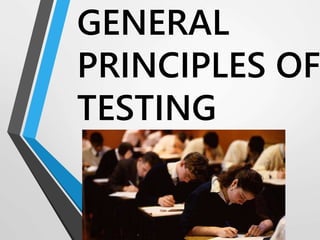
General principles of testing to Different qualities of high quality assessment
- 2. Testing •A technique of obtaining information needed for evaluation purposes. Test, quizzes, measuring instruments – devices for testing
- 3. 1. Measure All Instructional Objectives •Teachers should match the test items with the learning objectives posed during instruction. • That is why, the first step of test construction is to go back to the instructional objectives.
- 4. 1. Measure All Instructional Objectives •For example: Objective: "Given a sentence written in the past or present tense, the student will be able to re- write the sentence in future tense with no errors in tense or tense contradiction Test Item: Re-write the given sentence into its future tense.
- 5. 1. Measure All Instructional Objectives •For example: Objective: Given a list of words, the students will circle the noun with 90 % accuracy. Test Item: Give 10 examples of nouns.
- 6. 2. Cover all the learning tasks. •Construct a test that contains a wide range of sampling items. •A good learning task focuses and measures a representative sample of the teacher's learning objectives.
- 7. 3. Use appropriate test items. •A good test usually includes items that are most appropriate for a particular objective to check on learner achievement.
- 8. 4. Make test valid and reliable. •The test measures what is supposed to be measured from the students.
- 9. “A good test is said to be tested on a tripod.” The test measures what it claims to measure. Stability of the test scores Assessment and the procedures of administering the assessment are similar
- 10. 5. Use test to improve learning. •Discuss the skills or competencies on the items that have not been learned or mastered by the learners.
- 11. Five General Principles of Testing •Measure all instructional objectives. •Cover all the learning tasks. •Use appropriate test items. •Make test valid and reliable. •Use test to improve learning.
- 13. I. Clarity of the Learning Target •The Learning Target must be focused on student learning objectives. •The Learning outcomes must be SMART!
- 14. I. Clarity of the Learning Target •The performance task should be clearly presented. •The teacher should also discuss clearly the criteria.
- 15. II. Appropriateness of the Learning tool • Teachers should choose and develop the appropriate assessment methods. • Kinds of Assessment: 1. Objective test – multiple choice; choose the correct answer 2. Subjective test –original answers 3. Performance Assessment - perform real- world tasks
- 16. P O RT F O L I O
- 17. It is a systematic collection of student work and related material that depicts a student’s activities, accomplishments and achievements It measures the growth and development of the students.
- 18. It is a form of assessment that students do together with their teachers. The teachers guide the students in planning, execution and evaluation of contents of the portfolio.
- 21. It is used to collect assessment data by asking oral questions.
- 22. It is an effective way to stimulate student’s motivation and participation. It provides students with opportunities to practice self-expression
- 24. The behavior of students involved in his performance during instruction is systematically monitored, described, classified and analyzed. OBSERVATION TECHNIQUE
- 26. Formal observations are planned in advance. FORMAL OBSERVATION
- 27. It is done spontaneously. In other words, an unplanned opportunity emerges, in the context of classroom activities, where the teacher observes some aspect of individual student learning. INFORMAL OBSERVATION
- 29. The responses of the students may be used to evaluate both performance and attitude.
- 31. VALIDITY It refers to the appropriateness of score-based inferences; or decisions- made based on the students’ test result.
- 32. RELIABILIT Y It refers to the consistency of measurement; that is, how consistent test result or other assessment results from one measurement to another.
- 33. FAIRNESS The test item should not have any biases. A test can only be good if it is fair to all.
- 34. OBJECTIVIT YRefers to the agreement of two or more raters or test administrators concerning the score of a student. Lack of objectivity reduces test validity in the same way that the lack of reliability influence validity.
- 35. SCORABILITY It means that the test should be easy to score, direction for scoring should be clearly stated in the instruction. Provide the students an answer sheet and the answer key for the one who will check the test.
- 36. ADEQUACY It means that the test should contain a wide range of sampling of items to determine the educational outcome or abilities so that the resulting scores are representatives of the total performance areas measured.
- 37. ADMINISTRABILIT Y It means that the test should be administered uniformly to all students so that the scores obtained will not vary due to factors.
- 38. It refers to the teacher’s familiarity with the methods used, time required for the assessment, complexity of the administration, ease of scoring, ease of interpretation of the test results and the materials used must be at the lower cost.